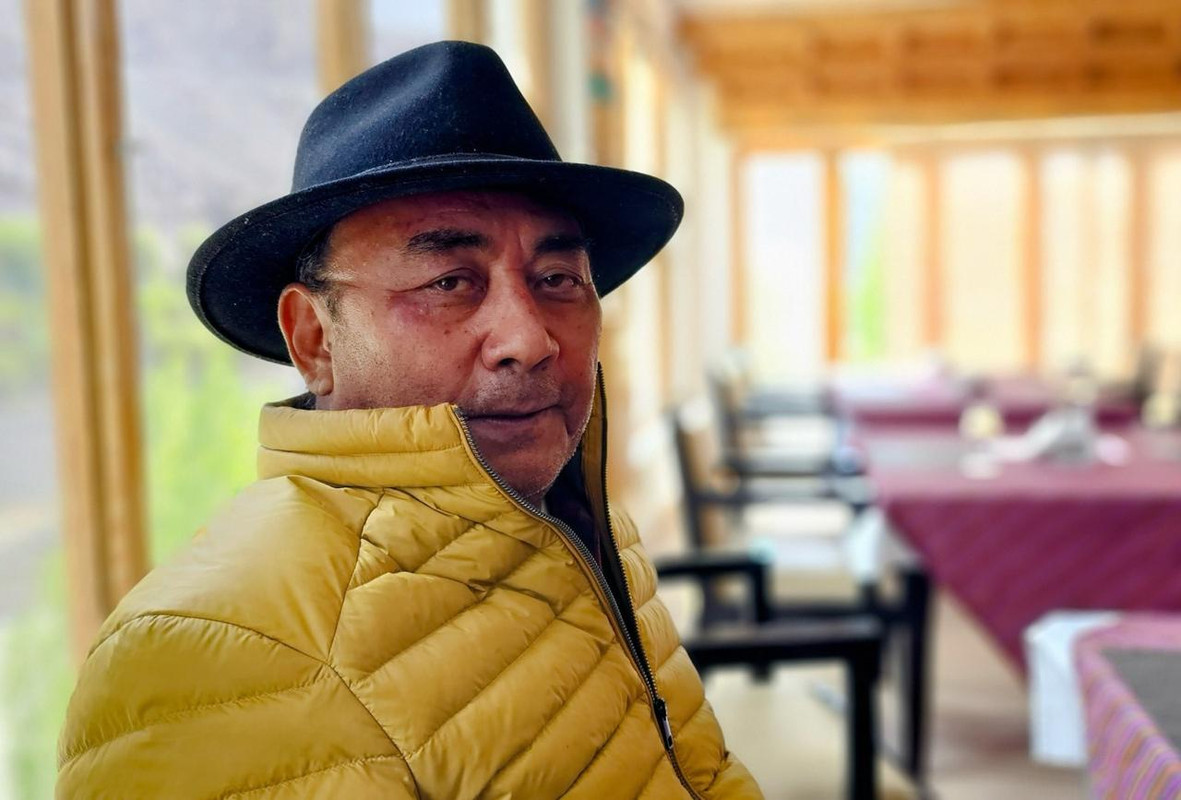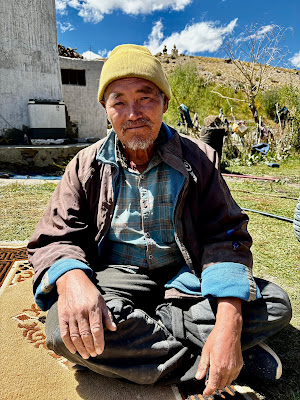At 89, Aba Jamspal still works daily in the family fields. He attributes his vitality to a youth filled with travel and adventure. His first encounter with the salt trade came when he was about fifteen, during a journey to the bustling markets of Sakti and Chemrey. He vividly recalls the scale of those markets, where hundreds of traders from across Ladakh and Baltistan gathered to barter. The Changpa herders arrived with sheep carrying lugals of salt, which were stacked into striking pyramid-shaped piles. At Sakti, Jamspal could trade his barley for salt, often three times the quantity.
The Shamma and Balti traders who came to Sakti passed through his village of Spituk. The Shamma travelled with donkeys, while the Baltis, relying on dzhos, would rest overnight in the village. Their arrivals turned Spituk festive, for the Baltis in particular would spend their evenings with song and dance that lasted until dawn.
The Baltis carried phatings and doltoks. The smaller doltoks were packed in hay-filled bags, while the larger ones were carried in stacked loads. Equally prized were the apricot kernels they transported. Each dzho bore at least one khal, about fifty kilograms, of kernels. In Ladakh’s village, as in the monasteries, apricot oil was indispensable, valued especially for lighting prayer lamps. The kernels were traded for barley in Spituk, and that barley was then exchanged for salt with the Changpas at Sakti. In a land where everything was scarce, nothing went to waste: villagers crushed the residue of the kernels, known as patsaa, boiled it for hours to reduce its sourness, and mixed it with toe to prepare a dish called tsanthuk. Such foods were vital to Ladakh’s subsistence economy.
Jamspal holds the Shamma traders in particular esteem, remembering them as among the most hardworking people he had ever known. After returning from Sakti with salt, many would forgo Losar celebrations and head straight to Kargil. There, some exchanged salt for rice brought by Balti traders, at the favourable rate of one measure of salt for one of rice, an even exchange compared to the three-for-one rate of salt for barley at Sakti. Others sold their salt in Kargil and pressed westward, crossing Zojila into Kashmir to purchase rice, which at the time cost one rupee for two kilograms.
Jamspal personally witnessed these trades in Kargil and Sonamarg. He was almost twenty when he travelled to Kargil to transport wool for “The Syndicate,” one of Ladakh’s cooperative organisations. Later, he joined fellow traders from the Tsokrun, Mogol, Rongo, and Chupsa families on journeys to Sonamarg to buy rice. These expeditions, he remembers, were as much about endurance and survival as they were about commerce.
One of the most vivid memories of his youth was tax collection. Villagers were required to clean their grain before delivering it to the government store in Leh. Yet, no matter how carefully they worked, some officials, Ladakhis themselves, would find fault. A chaprasi named Stanzin Dawa (name changed) became notorious for his cruelty. He would smear his palm with butter, dip it into the grain, and if even a speck of dust clung to his hand, he would reject the consignment. The villagers had no choice but to return home and clean the grain all over again.
The other memories, were of, wool being so scarce, that a team from Spituk monastery, monks and laypersons alike, travelled as far as Gertse in Tibet to procure it for weaving robes. As a child, Jamspal also saw groups of very well dressed, forty or fifty Dogra soldiers passing through Spituk to relieve counterparts at Leh’s Qila, part of the annual transfer of forces. He remembers, too, the Tungan and Kazakh refugees who fled Central Asia in the mid-1940s. They bartered a single roti for a sheep. Some wore hats resembling those of high lamas, and rumours spread that they had looted monasteries and nomadic settlements in Tibet, bringing with them both sheep and ceremonial hats.
Independence brought good news for Ladakhis. Salt and other essentials began to be distributed through the local ration shop. Families continued to save rice for Losar or to serve relatives during times of celebration and priods of mourning. Jamspal also expresses gratitude to the Indian Army, which in the 1940s and 1950s created large scale livelihoods for many Ladakhis,whether through enlistment or the spin-off trades its presence generated. A single trip from Spituk to Chorbat La with Army loads on horses could earn as much as thirty-six rupees. He also witnessed the first landing of Dakota aeroplanes in Spituk, an event that transformed the local economy. Each Dakota carried either twenty-four bags of flour or twenty-five cans of kerosene. A load transported from the airport to the Qila in Leh earned one rupee, while unloading at the airstrip paid two rupees per day. These opportunities encouraged villagers to acquire horses, which were soon employed almost exclusively for Army transport.









